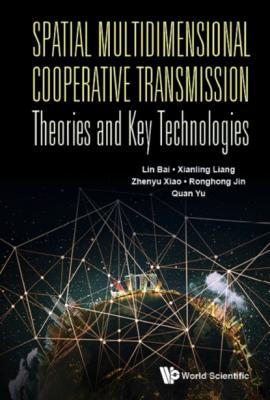Spatial Multidimensional Cooperative Transmission Theories And Key Technologies. Lin Bai
Читать онлайн.| Название | Spatial Multidimensional Cooperative Transmission Theories And Key Technologies |
|---|---|
| Автор произведения | Lin Bai |
| Жанр | Зарубежная компьютерная литература |
| Серия | |
| Издательство | Зарубежная компьютерная литература |
| Год выпуска | 0 |
| isbn | 9789811202476 |
It can be seen that the diversity gain is still MR.
For other constellations, using maximum likelihood detection,5 the error probability is
where
Since u is a χ2 variable, the average upper bound above is
when the SNR is large, Eq. (2.110) is simplified to
Similar to the case of BPSK, the diversity gain is equal to the number of receiving branches in an independent and identically distributed Rayleigh channel.
(3) Minimum mean square error combining
When the noise is spatially correlated or non-Gaussian interference occurs, the maximum ratio combining is no longer optimal. In this case, the minimum mean-squared error combining is an optimal gain combining, from which the weight is obtained by minimizing the mean square error between the transmitted symbol c and the combiner output z, namely
And it is easy to get the optimal weight vector
where Rni is the correlation matrix of noise and interference. When there is no interference, Rni = E{nnH}. If the noise across the antenna is white noise, then
2.3.2.3Reception diversity through hybrid selection combining or gain combining
A hybrid approach combines the selection algorithm with the maximum ratio combining. At each moment, the receiver first selects
Obviously, it can be concluded that the average SNR of the combiner output is the sum of the two items. The first item corresponds to the maximum ratio combining
Similarly, for selective combining (
2.3.3MISO system
The MISO system utilizes MT transmitting antennas with pre-processing or precoding to perform diversity at the transmitting end. And the obvious difference from reception diversity is that the transmitter may not have knowledge of the MISO system channel. Since the channel characteristics can be estimated at the receiving end, while the channel information needs to be fed back from the receiver to the transmitter at the transmitting end, there are basically two ways to obtain direct transmit diversity.
•When the transmitter has complete channel knowledge, beamforming can be achieved by various optimization metrics such as SNR and SINR to obtain diversity and array gain.
•When the transmitter has no channel information, the so-called space–time coding pre-processing can be used to obtain the diversity gain, but the array gain cannot be obtained.
In the following, different beamformers will be evaluated and several indirect transmit diversity techniques will be discussed, which can convert space diversity into time or frequency diversity.
2.3.3.1Transmit diversity formed by matched beamforming
This beamforming technique is also known as transmitting maximum ratio combining and it assumes that the transmitter knows all the information about the channel. In order to use diversity, signal c is appropriately weighted before being transmitted to each antenna. At the receiving end, the signal can be expressed as
where h = [h1 , . . . , hMR] denotes the MISO channel vector and W is the weight vector. And the weight vector that maximizes the received SNR is
where the denominator guarantees that the average total transmitting power remains unchanged and is equal to ES. This vector makes the transmission in the direction of the matched channel and is therefore also called the matched beamforming or conventional beamforming. Similarly, for reception maximum ratio combining, the average output SNR is ρout = MTρ, and therefore, the array gain is equal to the number of transmitting antennas MT. If the bit error rate has the following upper bound at a high SNR, the diversity gain is also equal to MR.
Therefore, the matched beamformer exhibits the same performance as the reception maximum ratio combining. It requires knowledge of the complete information of the transmitting channel, which means there is feedback from the receiver in the time duplex system. If frequency duplexing is adopted, the interchangeability of the upper and lower channels is no longer guaranteed, and the understanding of the channel information at the transmitting end is greatly reduced. In addition, the matched beamformer is optimal in the absence of interfering signals but cannot cancel the interference.
Similar to the aforementioned augmented selection algorithm for SIMO systems, the matched beamformer can be combined with the selective combining algorithm. In the beamformer, the transmitter selects
2.3.3.2Space–time coded transmit diversity
The beamforming technique described previously requires channel information for the transmitter to obtain optimal weights. Conversely,
